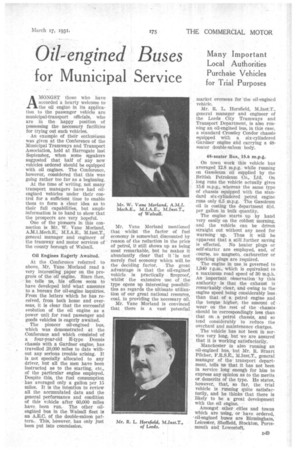Oil-engined Buses
Page 119

If you've noticed an error in this article please click here to report it so we can fix it.
for Municipal Service
AMONGST those who have accorded a hearty welcome to the oil engine in its application to the passenger vehicle are municipal-transport officials, who are in the happy position of possessing the necessary facilities for trying out such vehicles.
An example of their enthusiasm was given at the Conference of the Municipal Tramways and Transport Association, held at Harrogate last September, when some spgakers suggested that half of any new vehicles ordered should be equipped with oil engines. The Conference, however, considered that this was going rather too far as a beginning.
At the time of writing, not many transport managers have had oilengined vehicles under their control for a sufficient time to enable them to form a. clear idea as to their full capabilities, but ample information is to hand to show that the prospects are very hopefuL _ One of the pioneers in this connection is Mr. W. Vane Morland, A.M.I.Mech.E., M.I.A.E., M.Inst.T., general manager and engineer of the tramway and motor services of the county• borough of Walsall.
Oil Engines Eagerly Awaited.
At the Conference referred to above, Mr. Vane Morland read a very interesting paper on the progress of the off engine. Since then, he tells us, his offices seem to have developed intd what amounts • to a bureau for oil-engine inquiries. From the letters which be has received, from both home and overseas, it is dear that the successful evolution of the oil engine as a power unit for road passenger and goods vehicles is eagerly awaited.
The pioneer oil-engined bus, which was demonstrated at the Conferenee and which consisted of a four-year-old E-type Dennis chassis with a Gardner engine, has travelled 20,000 miles to date without any serious trouble arising. It is not specially allocated to any driver, but all the men have been instructed as to the starting, etc., of the particular engine employed. Despite this, the fuel consumption has averaged only a gallon per 15 miles. It is the intention to review an the accumulated data and the general performance and condition of this vehicle after 60,000 miles have been run. The other oilengined bus in the Walsall fleet is an A.E.C. of the double-saloon pattern. This, however, has only just been put into commission. Mr. Vane Morland mentioned that whilst the factor of fuel economy is somewhat discounted by reason of the reduction in the price of petrol, it still shows up as being most remarkable, but he makes it abundantly dear . that it is not merely fuel economy whicri will he the deciding factor. The great advantage is that the oil-engined . vehicle is practically . fireproof,whilst the extensive use of the type opens up interesting possibilities as regards the ultimate utilization of our great national resource, coal, in providing the necessary oil. Mr. Vane Morland is convinced that there is a vast potential . market overseas for the oil-engined vehicle.
Mr. R. L. Horsfleld, M.Inst.T., general manager and engineer of the Leeds City Tramways and Transport Department, is also running an oil-engined bus, in this case, a standard Crossley Condor chassis equipped with a six-cylindered Gardner engine and carrying a '48seater double-saloon body.
48-seater Bus„.15.6 m.p.g.
On town work this vehicle has averaged 12.8 m.p.g. while running on G'asoleum oil supplied by the British Petroleum Co., Ltd. On long runs the vehicle actually gives 15.6 m.p.g., whereas the same type of chassis equipped with the standard six-cylindered petrol engine runs only 6.5 m.p.g. The Gasoleum oil is costing the department CA. per gallon in bulk quantity.
The engine starts up by hand very easily on the coldest morning, and the vehicle can be driven straight out without any need for warming. up. Thus it will be apparent that a still further saving is effected. No heater plugs or self-starter are employed, and, of course, no magneto, carburetter or sparking plugs are required.
The engine in use is governed to 1,340 r.p.m., which is equivalent to a maximum road speed of 30 m.p.h. An important observation' by this authority is that the exhaust isremarkably clear, and owing to the engine speed being considerably less than that of a petrolengine and the torque higher, the amount of wear on the rest of the chassisshould be correspondingly less than that on a petrol chassis, and so tend considerably to reduce the overhaul and maintenance charges.
The vehicle has not been in service very long, but we are assured that it is working satisfactorily.
Manchester its also running an oil-engined bus, but Mr. R. Stuart Filcher, F.R.S.E., M.Inst.T., general manager of the transport department, tells us that it has not been in service long enough for him to express any opinion as to the merits or demerits of the type. He states, however, that, so far, the trial vehicle is running quite satisfactorily, and he thinks that there is likely to be a great development with the oil engine.
Amongst other cities and towns which are using, or have ordered. .oil-engined buses are Birmingham. Leicester, Sheffield, Stockton, Portsmouth and Lowestoft.
























































































































































































